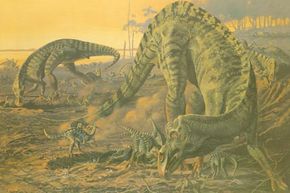MAIASAURA (MY-ah-SORE-ah)
Period: Late Cretaceous
Advertisement
Order, Suborder, Family: Ornithischia, Ornithopoda, Hadrosauridae
Location: North America (United States)
Length: 30 feet (9 meters)
Since it was named in 1979 by John Horner and Robert Makela, Maiasaura has become one of the most famous dinosaurs. It has provided information about how it cared for its young and the early development of dinosaurs.
The name Maiasaura means "good mother reptile." This large dinosaur laid her eggs in a mound of dirt in a circular or spiral pattern. Then she covered the mound with vegetation, much like crocodiles do today. The eggs were warmed by the rotting (composting) vegetation. Rather than sitting directly on the nest, mother Maiasaura probably sat next to it to keep thieves from stealing the eggs and other maiasaur parents from walking on them. Because females of a herd made nests in the same area, this would have been a danger.
When the eggs hatched, the hatchlings were too immature to leave the nest. Their limbs were not well developed, but there was wear on their teeth. This means the hatchlings stayed in their nests and their parents brought them food. The young Maiasaura probably lived in nests until they were a year or two old. They grew from about 16 inches to 58 inches in only a year; this is rapid growth and may mean that they were warm-blooded.
A hatchling Maiasaura had a tall, narrow head. As it grew, its head became lower and wider from back to front, with a board horny beak. Over its eyes was a stout bony crest that probably was used for display and head-butting during breeding season or when defending territory. Because these dinosaurs lived in very large groups, with up to 10,000 animals in a herd, they needed to protect their territory.
All the Maiasaura specimens come from the Late Cretaceous Two Medicine Formation of western Montana. Orodromeus also lived in this area at the same time, as well as the predators Albertosaurus and Troodon. Maiasaura has not been found in other areas of the west.
We know more about the life of Maiasaura than any other dinosaur; we also know a lot about its evolutionary relationships. The closest relative of Maiasaura was Brachylophosaurus from southern Alberta and Montana. More remotely, these two solid-crested hadrosaurids were related to the more primitive Hadrosaurus, Aralosaurus, and Gryposaurus.
Advertisement
